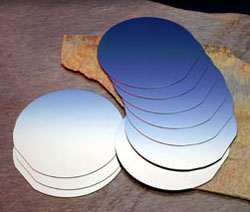Crystal Clear Memory

Ferroelectric crystals can remember sounds. So say researchers who sent acoustical waves through a lithium niobate sample and saw the tone reappear a moment later. The team, publishing in the 9 September print issue of PRL, thinks the effect could serve as a non-destructive probe of the material, which is commonly used in telecommunications devices.
A ferroelectric works just like a ferromagnet. Heating it above a certain temperature and then slowly cooling it, all in the presence of an electric field, causes the material to produce a similar electric field. Polarized domains of atoms gradually align during the cooling process and generate a field that is “remembered” after the applied field is turned off. In another feat of memory, researchers reported two years ago that a light-induced electric field could imprint a new refractive index along one dimension of a ferroelectric crystal.
Now Mack Breazeale and his group at the University of Mississippi in University have found a new form of memory in ferroelectrics. They sandwiched a slip of lithium niobate ( ) between two transducers, one to send a sound wave in and another to measure the output. When they applied a tone pulse to the crystal, it briefly rang like a bell and then quieted. But to their surprise, a signal with the same frequency and phase popped up after a 70-microsecond delay. The ferroelectric had apparently stored energy from the acoustical wave and then released it. “It’s completely unexpected,” says Michael McPherson, a graduate student who performed the experiments. The memory signal could not be detected at temperatures above 75 degrees Celsius , where the charges within the domains behave differently. It’s amplitude also depended upon the frequency of the applied pulse, being strongest at 26 MHz in the experimental samples.
Ferroelectrics are piezoelectric–they can turn vibrations into electromagnetic waves–so the authors believe the sound pulse generates an electric field that temporarily displaces charges within the crystal, moving them to the edges of the ferroelectric domains. In the next instant, “the whole system sort of snaps back,” says McPherson, and begins vibrating again. They think the magnitude of the echo depends on the concentration of the domains in the crystal. The larger the concentration of domains and ions, the more charges can be displaced and snap back. When they estimated the resonant frequency of the domains in their crystals, it matched the frequency of the strongest echoes.
McPherson says the technique might serve to characterize the domain sizes, and therefore quality, of optically polarized lithium niobate, used in lasers and other optical devices for telecommunications. Currently technicians use x-ray diffraction, which has high resolution but doesn’t penetrate far into a sample.
The effect is new and surprising, says Sergei Ostapenko of the University of South Florida in Tampa, but “the physical model is definitely very speculative at this point and requires more detailed study.” If confirmed, he agrees the memory effect could be important for optimizing lithium niobate crystallization techniques.
–JR Minkel
JR Minkel is a freelance science writer in New York City.


